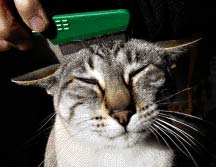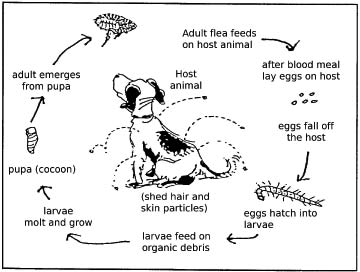Bringing information you can use for action about herbicides, pesticides and other toxic chemicals in northern California and around our shared world
Welcome!
CATs at Work
Our Shared World
Online Store
Programs
Fleas
NATURAL FLEA CONTROL – A comb and a good vacuum keep the home healthy
When your pet has fleas, controlling this little insect is not an easy task. While insecticides may seem like the quick fix, getting lasting control is possible through non-toxic, natural means. The first step is to vacuum your house thoroughly, including the floors, corners, upholstery, sofa cushions, and under the couch--and repeat often. Immediately secure the vacuum bag by sealing it in a plastic bag and dispose of it quickly and away from your house. Wash all throw rugs and your pets bedding in hot water. Sprinkle diatomaceous earth in the carpet to kill fleas on contact. Bathe your pet in natural shampoo with plant essential oils and follow with a thorough flea combing. A flea comb can be found at a pet store. Regular use of a flea comb along with washing your pet’s bedding is the best method for flea control. Fleas and eggs are caught in the fine comb, and can be rinsed off in a bowl of soapy water.

Grooming is not only good for your pet
but it also helps keep a healthy home
free of fleas, ticks and mites
OUTSIDE
To control fleas outside of the home, sprinkle diatomaceous earth (a product found at your local home and garden store) over the lawn, under bushes and in shady areas. Diatomaceous earth is made from the shells of tiny sea creatures called diatoms. The tiny shells scratch the fleas exoskeleton, causing the insect to dehydrate and die.
POPULAR REMEDIES FOR NON-TOXIC FLEA CONTROL
- A touch of vinegar in your pet’s water is suggested to control both fleas and mange
- Try lavendar, lemongrass, peppermint and/or citronella essential oils mixed with water as a repelent spray that smells great
- A saltwater dip may discourage fleas – If you live near the ocean have your dog swim in the sea
- Buy a sticky trap such as “Over Nite Flea Trap” or “Gardens Alive Flea Trap” and place it where you see the most fleas
- Create your own flea trap! Place a light six inches over a bowl of water containing a small amount of detergent. Fleas attracted by the light will fall into the bowl and drown (be careful not to create a fire hazard)
FLEA LIFE CYCLE
The flea life cycle includes four stages of development: egg, larva, pupa, and adult. Fleas prefer warm, moist conditions (65-80 F and 70 percent relative humidity). Females lay up to 800 eggs in a lifetime, which are laid both on and off of a pet. The eggs hatch in 2 to 12 days into worm like larvae. The larval state generally last 1 to 3 weeks, but in unfavorable conditions this stage may last 200 days. The larvae spin a cocoon and transform into pupae. Pupae remain in a dormant stage until they detect a host, by warmth or vibration, then emerge as adult fleas. Adult fleas immediately seek a blood meal. They can live 1 to 2 months without a meal and can survive 7 to 8 months with just one meal.

TOXIC FLEA-CONTROL PRODUCTS
Common methods of flea control include the use of pesticides. Chemicals found in flea collars and powders can cause skin irritations. Pets may be harmed when they breath vapors from the product or lick the chemicals from their fur when grooming. Many flea collars contain the chemical DDVP (dimethyl dichlorovinyl phosphate), which affects the insects nervous system and may have the same effect on the pet. Another chemical commonly found in flea control products is carbaryl (Sevin), which is also toxic to the central nervous system.
Got Fleas? Get the Vacuum
Wed Dec 19, 2007 10:11am EST
WASHINGTON (Reuters) - Vacuum cleaners kill fleas just as well as any poison, surprised U.S. researchers said on Tuesday.
They said a standard vacuum cleaner abuses the fleas so much it kills 96 percent of adult fleas and 100 percent of younger fleas.
So no need to worry that a vacuum cleaner bag may turn into a fleabag breeding ground for the pesky, biting creatures, said Glen Needham, associate professor of entomology at Ohio State University.
Needham studied the cat flea, or Ctenocephalides felis, the most common type of flea found in households.
"No matter what vacuum a flea gets sucked into, it's probably a one-way trip," Needham said in a statement.
Writing in the journal Entomologia Experimentalis et Applicata, Needham suggested that the vacuum brushes wear away a waxy outer layer on insects called the cuticle. Without it, the fleas, larvae and pupae probably dry up and die, he said.
The findings were so surprising that the researchers ran their experiment several times.
"We didn't do a post-mortem, so we don't know for sure. But it appears that the physical abuse they took caused them to perish," Needham said.
Fleas spread diseases such as plague and can transmit worms.
"There are all kinds of ways to manage the problem, but how people feel about insecticides and how much money they want to spend factors into what they're going to do for flea control. Vacuuming is a great strategy because it involves no chemicals and physically removes the problem," Needham said.





